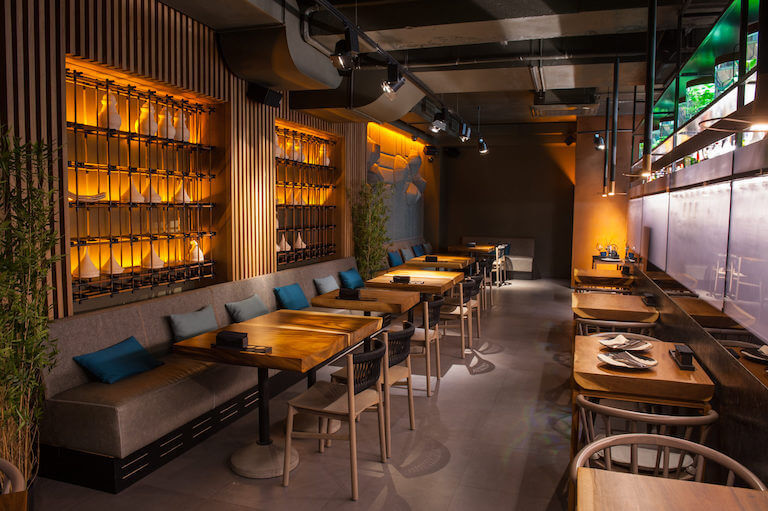Pan Asian Restaurant Islamabad: Discover Exquisite Asian Food
Pan Asian Restaurant Islamabad: Discover Exquisite Asian Food
Blog Article
Savor Genuine Asian Food With a Pan-Asian Spin for a Culinary Adventure
Getting started on a culinary journey through genuine Oriental cuisine, improved with a Pan-Asian twist, uses a special possibility to discover the rich tapestry of tastes that specify the area's varied cooking traditions. This experience invites you to appreciate the charming balance of tastes-- sweet, salted, spicy, and sour-- integrated by fragrant natural herbs and flavors. Visualize the ingenious combination of Thai curry and ramen or the unanticipated joy of sushi burritos. As you contemplate these enticing dishes, take into consideration the social narratives and historical impacts that form them, each bite offering a tale waiting to be found.

Checking Out Pan-Asian Flavors
In the world of worldwide gastronomy, Pan-Asian food stands out for its remarkable variety and the unified interaction of flavors from various Eastern cultures. This cooking method commemorates the abundant customs and unique ingredients discovered throughout the continent, developing a tapestry of tastes that is both rewarding and intriguing. Secret to Pan-Asian food is its ability to balance different tastes-- sweet, salty, spicy, and sour-- while highlighting the quality and high quality of each ingredient.
From the umami-rich soy sauce of Japan to the fiery chili peppers of Thailand, Pan-Asian cuisine offers a considerable scheme of tastes. These components are commonly combined in creative ways, enhancing meals with layers of complexity. For example, the usage of aromatic herbs such as lemongrass and cilantro, usual in Vietnamese and Thai cuisine, adds a refreshing brightness to meals, while the consolidation of coconut milk provides a luscious, rich appearance.
The emphasis on fresh fruit and vegetables and fragrant flavors makes certain that each dish is not just a banquet for the palate however likewise for the senses. Pan-Asian cuisine invites restaurants to begin on a culinary journey, checking out the large and varied landscapes of Asian gastronomy with every bite.
Fusion Dishes to Attempt
While Pan-Asian cuisine is celebrated for its typical flavors, the modern cooking landscape is progressively accepting fusion meals that blend these timeless aspects with influences from various other regions. This ingenious method not just honors the rich heritage of Eastern cookeries yet additionally introduces unique taste experiences that appeal to modern tastes.
An archetype of such a blend meal is the Korean-Mexican taco, where marinated bulgogi beef is wrapped in a cozy tortilla, topped with kimchi and a spicy gochujang-infused salsa. This combination weds the bold, mouthwatering flavors of Korea with the vibrant, fresh aspects of Mexican food. Similarly, sushi burritos have obtained popularity, integrating the fragile virtuosity of Japanese sushi with the passionate, hand-held ease of a burrito, frequently including combination components like tempura shrimp and avocado with a drizzle of wasabi mayo.
Another notable meal is Thai curry ramen, which infuses the velvety, fragrant seasonings of Thai curry into the comforting broth of conventional Japanese ramen, producing a harmonious mix that entices the detects. These blend dishes expand beyond mere novelty; they represent a cooking dialogue between cultures, encouraging exploration and technology in the world of Pan-Asian cuisine.
Necessary Active Ingredients and Flavors
To absolutely value Pan-Asian food, one need to recognize the important components and spices that form its foundation. This diverse cooking style draws from an abundant tapestry of Asian traditions, using a harmonious blend of textures and tastes.
Aromatic elements are critical, with lemongrass, garlic, and ginger being ubiquitous across numerous Pan-Asian dishes. These components provide a great smelling base that boosts the intricacy of zorbas flavors. Seasonings such as star anise, cardamom, and cinnamon present heat and personality, resembling influences from areas like China and India.

Cooking Techniques and Tips
Grasping the art of Pan-Asian food calls for knowledge with its distinct food preparation techniques, each adding to the lively tapestry of flavors this culinary practice is celebrated for. Central to these approaches is the stir-fry, a fast cooking method that protects the dietary stability and vibrant shades of components. Using a wok, the stir-fry approach enables also warm circulation, vital for accomplishing the particular appearance and taste equilibrium of Pan-Asian meals.
An additional fundamental method is steaming, specifically widespread in Chinese food. This mild approach keeps the all-natural tastes and nutrients of active ingredients, making it perfect for fish and home shellfish and veggies. Dumplings, a precious staple, usually benefit from steaming, causing soft, delicious textures.
Barbecuing, additionally indispensable, presents great smoky depths to dishes such as Korean bulgogi or Japanese yakitori (best asian restaurant Islamabad). This technique often involves seasoning active ingredients, enabling flavors to permeate deeply prior to cooking over an open fire or warmer
Lastly, mastering the art of balancing tastes-- wonderful, sour, salted, bitter, and umami-- is vital. Properly layering these aspects can elevate a recipe from common to amazing, providing a complex and satisfying cooking experience that symbolizes the essence of Pan-Asian food.
Eating Experiences Worldwide
Throughout the world, Pan-Asian food offers an exceptional eating experience, celebrated for its rich tapestry of flavors and lively presentations. This culinary phenomenon has gone beyond social limits, recording the hearts and palates of food fanatics worldwide. In multicultural cities fresh York, London, and Sydney, Pan-Asian restaurants act as fusions where culinary practices from Thailand, Japan, China, and beyond assemble, giving diners with an eclectic mix of dishes that highlight the area's diversity.
The international allure of Pan-Asian food depends on its capacity to use both credibility and advancement. Chefs masterfully wed conventional ingredients such as lemongrass, soy sauce, and miso with contemporary methods, causing dishes that are both familiar and refreshingly new. This combination allows diners to start a cooking journey that appreciates heritage while accepting modernity.
Additionally, eating experiences are my site raised with thoughtfully made environments that mirror the principles of Pan-Asian aesthetics. From minimalist Japanese-inspired interiors to vivid Thai-themed areas, each restaurant offers a special setting that complements the cooking offerings. As a result, customers are not merely eating a dish however partaking in a cultural experience, making Pan-Asian dining a really international sensation.
Conclusion
The exploration of Pan-Asian food offers an extensive understanding of the detailed interplay of flavors and culinary practices across Asia. By accepting fusion recipes such as Thai curry ramen and sushi burritos, the culinary journey not only highlights the versatility of typical components yet also showcases cutting-edge modern methods. This gastronomic journey, improved by crucial flavors and cooking methods, offers an unique possibility to value the cultural variety and culinary virtuosity that define Pan-Asian cuisine on an international range.
Beginning on a cooking trip via genuine Oriental food, enhanced with a Pan-Asian twist, offers a special opportunity to check out the rich tapestry of tastes that define the area's varied culinary customs.In the realm of global gastronomy, Pan-Asian food stands out for its remarkable diversity and the harmonious interplay of flavors from various Oriental cultures. Secret to Pan-Asian food is its ability to balance different flavors-- wonderful, salty, spicy, and sour-- while highlighting the freshness and top quality of each ingredient.

Report this page